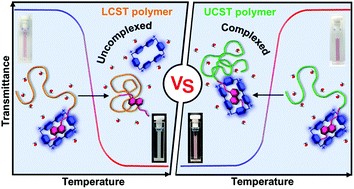Mechanism insights in controlling host–guest (de)complexation by thermoresponsive polymer phase transitions†
Abstract
The combination of (thermo)responsive polymers with supramolecular chemistry recently allowed the development of adaptative materials based on the reversible regulation of host–guest complexation. The properties of these artificial systems rely on their synthetic design, which requires a perfect understanding of the mechanisms triggering the thermo-induced decomplexation. Despite recent progress, the origins of this phenomenon are still not fully understood. To investigate the effect of phase separation mechanism and thermodynamics on the host–guest (de)complexation behavior, different naphthalene-functionalized (guest) thermoresponsive polymers, including lower critical solution temperature (LCST) and upper critical solution temperature (UCST) polymers, were prepared. The host–guest complexation of the polymers with cyclobis(paraquat-p-phenylene) (Blue Box) was investigated in water at different temperatures. Host–guest complexation was lost upon heating-induced hydrophobic phase separation of complexed guest-functionalized LCST-polymers, while, in contrast, the host–guest complex was retained upon cooling-induced hydrogen bond-driven phase separation of a complexed guest-functionalized UCST polymer. This comparative analysis showed that the mechanism behind the thermoresponsive polymer phase separation is a key factor that dominates the host–guest (de)complexation.

- This article is part of the themed collection: Polymer Chemistry Lectureship Winners


 Please wait while we load your content...
Please wait while we load your content...